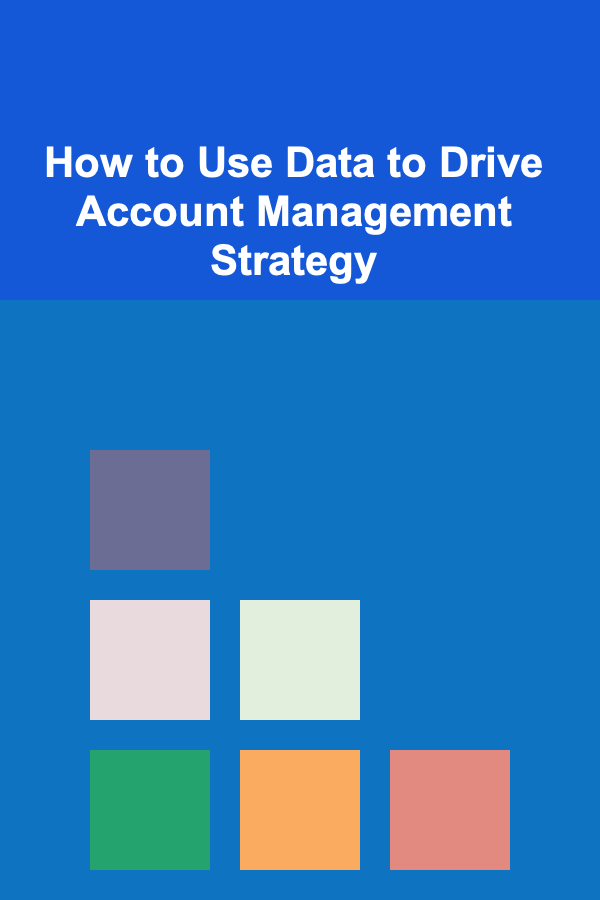
How to Use Data to Drive Account Management Strategy
ebook include PDF & Audio bundle (Micro Guide)
$12.99$11.99
Limited Time Offer! Order within the next:

In today's business landscape, data has become the backbone of decision-making processes. Account management is no exception, with data being a crucial tool for building better relationships, increasing customer satisfaction, and driving business growth. Whether you are managing a portfolio of customers or overseeing complex B2B relationships, utilizing data effectively can transform your account management strategy from reactive to proactive, and from transactional to strategic.
In this article, we'll explore how to harness data to drive your account management strategy, offering insights into how data can be used to optimize processes, create personalized strategies, and deliver higher value to clients.
Understand the Role of Data in Account Management
Before diving into how to use data, it's important to understand its role in account management. Account management isn't just about managing accounts; it's about nurturing relationships and providing value to your clients. In this context, data can be used to enhance decision-making, identify opportunities, reduce risks, and improve customer satisfaction.
Data in account management typically comes from various sources, including CRM systems, customer surveys, social media analytics, transaction history, and customer support interactions. When used effectively, this data provides a 360-degree view of the client and enables managers to make informed decisions based on insights rather than intuition.
Key Benefits of Using Data in Account Management:
- Personalized Customer Experience: Data helps account managers understand customer preferences and pain points, which can be used to offer tailored solutions.
- Proactive Issue Resolution: By analyzing historical data, account managers can predict and mitigate potential issues before they arise.
- Strategic Planning: Data helps identify trends and patterns that can inform long-term account strategies.
- Efficiency: Automation and data-driven processes allow for more streamlined and effective account management, reducing manual work and errors.
Collect and Organize Data Effectively
The first step in using data for account management is to collect and organize it in a way that makes it accessible and actionable. Without the right systems and processes in place, data can become overwhelming, making it difficult to extract meaningful insights.
a) Utilize CRM Systems
Customer Relationship Management (CRM) systems are essential tools for account managers, as they allow for the centralized collection of customer data. These systems track everything from contact information to historical interactions, purchase patterns, communication preferences, and service requests. Popular CRM systems like Salesforce, HubSpot, and Zoho provide an organized platform for managing customer data.
CRMs help keep all account data in one place, making it easier for account managers to track client progress, understand the status of ongoing projects, and identify any potential risks. Additionally, many CRMs offer reporting features that allow account managers to visualize trends and make data-driven decisions.
b) Use Data Integration Tools
For businesses that utilize multiple software platforms (e.g., marketing, sales, and customer service software), data integration tools such as Zapier, MuleSoft, or PieSync can help streamline data flow between systems. These tools ensure that the data remains consistent and up-to-date across all platforms, making it easier for account managers to access the most current information about their clients.
c) Data Cleansing
Data cleansing is the process of identifying and correcting inaccurate or incomplete information. Incomplete or outdated data can lead to poor decision-making and negatively impact the customer experience. Regularly cleaning your customer data ensures its accuracy, which is essential for effective account management.
Segment Your Accounts Based on Data Insights
Once the data is collected and organized, account managers can start segmenting their client base to better understand their customers and create targeted strategies. Account segmentation is a method of dividing your accounts into different groups based on shared characteristics such as industry, size, revenue, purchase history, or behavior.
a) Use Demographic and Firmographic Data
Demographic data (such as age, gender, or location) and firmographic data (such as company size, revenue, and industry) are critical for segmenting accounts. Understanding the unique characteristics of each segment allows account managers to create more relevant strategies that cater to the specific needs of different client groups.
For example, small businesses may have different needs and expectations compared to large enterprises. Using data to understand these differences enables account managers to tailor their approach, whether it's offering personalized product recommendations or adjusting communication strategies.
b) Segment by Behavior
Behavioral data, such as how often customers purchase products, what products they buy, and how they interact with your company, provides deeper insights into client preferences. This allows account managers to segment accounts based on their buying behavior. For example, high-value customers who make frequent purchases might be given priority in communication or special offers, while less engaged customers could benefit from a re-engagement campaign.
c) Lifetime Value (LTV) Segmentation
Customer Lifetime Value (LTV) is a metric that estimates the total value a customer will bring to your business over the course of their relationship with you. By segmenting your accounts based on LTV, account managers can focus their efforts on retaining high-value customers, increasing revenue from them, and identifying opportunities to upsell or cross-sell.
Leverage Predictive Analytics to Anticipate Client Needs
Predictive analytics uses historical data, statistical algorithms, and machine learning techniques to predict future outcomes. In the context of account management, predictive analytics can be used to identify potential risks, forecast client needs, and suggest actions to improve customer satisfaction.
a) Predicting Churn
Churn prediction is one of the most powerful applications of predictive analytics in account management. By analyzing past customer behavior, account managers can identify early signs of churn, such as a decline in purchase frequency or customer engagement. Early identification of at-risk customers allows account managers to take proactive steps to retain them, such as offering incentives, addressing concerns, or providing additional value.
b) Upselling and Cross-Selling Opportunities
Predictive analytics can also help account managers identify upsell and cross-sell opportunities. By analyzing transaction history and customer preferences, predictive models can suggest products or services that clients may be interested in based on their past purchasing behavior. This allows account managers to tailor their sales approach and increase revenue from existing accounts.
c) Customizing Offers and Communication
Using predictive analytics, account managers can deliver more personalized offers and communication to their clients. For instance, if a customer frequently purchases a particular product, predictive analytics can help forecast when they might need a replacement or an upgrade, enabling account managers to send timely offers that increase conversion rates.
Automate Repetitive Tasks to Increase Efficiency
One of the primary benefits of using data in account management is the ability to automate repetitive tasks, allowing account managers to focus on higher-value activities. Many account management processes can be automated, such as sending follow-up emails, generating reports, scheduling meetings, and tracking customer satisfaction.
a) Email Campaigns and Alerts
Automation tools like Mailchimp, HubSpot, and ActiveCampaign allow account managers to set up email campaigns that are triggered based on specific customer behaviors. For example, after a customer makes a purchase, an automated thank-you email can be sent. Additionally, alerts can be set up to remind account managers to follow up with clients based on predefined timelines or when certain actions occur.
b) Reporting and Analytics
Data analytics tools such as Google Analytics, Tableau, and Microsoft Power BI allow account managers to automatically generate reports on account performance, customer satisfaction, and sales metrics. These reports can be customized to focus on key metrics that drive account management decisions, such as LTV, churn rate, and engagement metrics.
c) Task Management and Workflow Automation
Workflow automation tools like Asana, Trello, or Monday.com can be used to automate task assignments and project tracking. For instance, if a customer submits a request for support, an automated workflow can trigger a series of actions, such as notifying the appropriate team member and sending an acknowledgment email to the client. This streamlines the process, reduces delays, and improves client satisfaction.
Measure Performance and Optimize Strategies
Data is not just for making decisions -- it's also essential for measuring the effectiveness of your account management strategy. By continuously analyzing performance metrics, account managers can identify areas for improvement and refine their strategies over time.
a) Customer Satisfaction Metrics
Customer satisfaction is a key indicator of the success of an account management strategy. Data from surveys, Net Promoter Scores (NPS), and customer feedback can provide insights into how satisfied clients are with the service they are receiving. Low satisfaction scores can highlight areas where improvements are needed, such as communication, product quality, or customer support.
b) Track Key Performance Indicators (KPIs)
KPIs such as revenue growth, upsell success, churn rate, and engagement levels provide valuable insights into the effectiveness of account management strategies. By tracking these KPIs regularly, account managers can identify trends and adjust their approach to ensure they are meeting client needs and achieving business goals.
c) A/B Testing
A/B testing is a technique used to compare two versions of a strategy to see which one performs better. In account management, A/B testing can be used to test different approaches, such as communication styles, offers, or account engagement strategies. By using data to test and optimize strategies, account managers can continuously improve their performance.
Foster Strong Client Relationships
Finally, one of the most important roles of an account manager is to build and maintain strong relationships with clients. Data can help in this area by providing account managers with the tools they need to engage with clients more effectively and deliver personalized, value-driven interactions.
a) Tailored Communication
By analyzing customer data, account managers can craft personalized messages that resonate with clients. For example, if a client has expressed interest in a particular feature of your product, the account manager can tailor the communication to highlight how that feature can address the client's pain points. Personalized communication shows that you understand the client's needs and strengthens the relationship.
b) Real-Time Interaction
With the help of data, account managers can engage with clients in real-time, offering instant support or guidance. For instance, if a client has a question or an issue with the product, data can help the account manager quickly find relevant information or direct the client to the right resources. Real-time interaction helps build trust and loyalty.
c) Consistent Touchpoints
Using data, account managers can identify the optimal frequency and channels for client communication. By ensuring that clients are regularly engaged through phone calls, emails, or meetings, account managers can maintain strong relationships and ensure clients feel valued.
Conclusion
Data-driven account management is no longer just an option; it's a necessity for businesses looking to stay competitive in a customer-centric marketplace. By collecting and analyzing relevant data, account managers can gain valuable insights into customer preferences, identify opportunities for growth, and proactively address issues before they become problems.
By segmenting accounts, leveraging predictive analytics, automating processes, and continuously optimizing strategies, businesses can improve customer satisfaction, increase retention, and ultimately drive greater revenue. Data not only empowers account managers to make smarter decisions but also fosters stronger, more personalized relationships with clients -- making it a fundamental tool in modern account management.
Reading More From Our Other Websites
- [Organization Tip 101] What Are the Key Steps to Organizing Your Bathroom?
- [Organization Tip 101] How to Create a Family-Friendly Staging Strategy
- [Organization Tip 101] How to Celebrate Milestones with Long-Term Tenants
- [Personal Investment 101] How to Use Fixed-Income Investments to Provide Stability in Your Portfolio
- [Organization Tip 101] How to Create a Pet-Friendly Cleaning Supply Station
- [Home Budget Decorating 101] How to Transform Your Space with Low-Cost Interior Design: Maximizing Style on a Shoestring
- [Personal Investment 101] How to Create Passive Income Streams with AI-Powered Tools
- [Home Soundproofing 101] How to Soundproof Your Home Without Sacrificing Aesthetic Design
- [Star Gazing Tip 101] Star-Gazing 101: How to Turn Your Backyard into a Family Astronomy Playground
- [Simple Life Tip 101] Best Simple Strategies for Maintaining a Clean Car Interior

How to Build a Checklist for Maintaining Consistency in Content Creation
Read More
How to Discover Advances in Stroke Recovery
Read More
How to Minimize Vacancy Rates in Your Rental Property
Read More
How to Use Holiday Decorations to Create Cozy Vibes in Your Home
Read More
10 Tips for Using Fabric and Textiles as Photo Props
Read More
10 Essential SEO Checklist Items for Bloggers
Read MoreOther Products

How to Build a Checklist for Maintaining Consistency in Content Creation
Read More
How to Discover Advances in Stroke Recovery
Read More
How to Minimize Vacancy Rates in Your Rental Property
Read More
How to Use Holiday Decorations to Create Cozy Vibes in Your Home
Read More
10 Tips for Using Fabric and Textiles as Photo Props
Read More